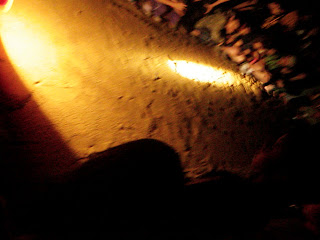
This event was organised by the Malaysian Nature Society, MNS for its members FOC. Just sign up and be there.
We had time to browse through the exhibits in the centre.

We had time to browse through the exhibits in the centre.

We were then led to the beach to watch 20 hatchlings being released. We were instructed to refrain from shining and taking flash photography so as to not confuse the hatchlings. The hatchlings went towards the light and swam off into the sea. Hatchlings tend to go towards well lit areas and many have wandered onto roads confused by streetlights.
The rest of the hatchlings would be released on different stretches of the beach.
The rest of the hatchlings would be released on different stretches of the beach.
While the rest of the group were in the seminar room getting a briefing on turtles in Malaysia, DH had an informative chat with a local, Pak, who worked for the Fisheries Dept. and WWF.
The locals find selling turtle eggs to resorts along Pengkalan Balak lucrative and had made efforts to retrieve and save the eggs difficult and dangerous - his fishing boat was torched once and there was an attempt to burn the centre down and staff have been threatened by the locals.
Also he said that if it were not for the efforts of WWF, the turtles in Pengkalan Balak would have been long gone.
Pak would collect the eggs and record the number of eggs and tag on the mother. He is paid according to the number of eggs collected.
Also he said that if it were not for the efforts of WWF, the turtles in Pengkalan Balak would have been long gone.
Pak would collect the eggs and record the number of eggs and tag on the mother. He is paid according to the number of eggs collected.
Turtles lay their eggs from April to September.
The highest number he had on record was in June.
Each time a turtle lays about a hundred eggs each time it comes ashore and would come again in consecutive nights until it lays about 600 hundred eggs in total.
Pak went on to warn about the beach saying that certain spots are 'unclean'. He pointed to a dark area that was partially lit by a street light. Saying that swimmers can drown barely 5 feet from the shore. He says that whenever a crocodile is spotted, that is an indication that a death could occur soon. There are certain areas along the beach that he would never trespass. Eerie.
We went for a quick bite down the road. Halfway through our meal of ikan bakar, the man at the barbecue pit ran to our table saying a turtle had been spotted. He told us to leave our food and have a look. The kids weren't the least bit interested. Too engrossed in their nasi goreng.
Turtle news travel fast along this stretch, no wonder Pak has a tough time beating the locals to the eggs.
Turtle news travel fast along this stretch, no wonder Pak has a tough time beating the locals to the eggs.



No comments:
Post a Comment